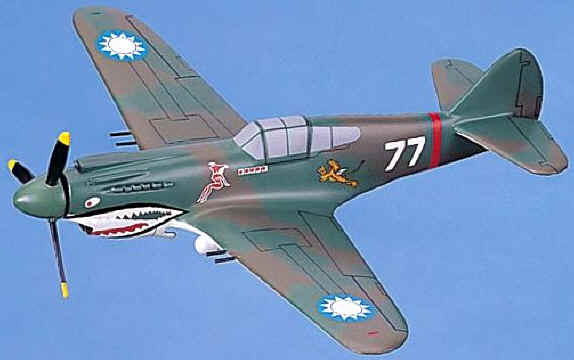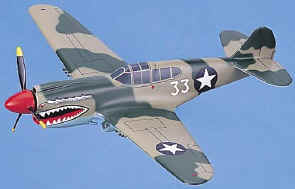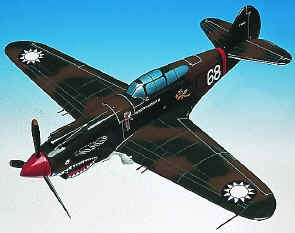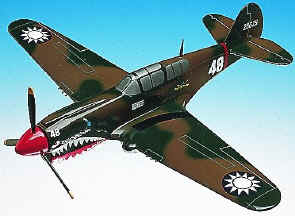|
|
|

|
Curtiss
P-40, Warhawk, Kittyhawk, Tomahawk |
 |
The P-40 was America's foremost fighter in service
when WWII began. P-40s engaged Japanese aircraft during the attack
on Pearl Harbor and the invasion of the Philippines in December
1941. The P-40 served in numerous combat areas - -the Aleutian
Islands, Italy, the Middle East, the Far East, the Southwest
Pacific and some were even sent to Russia. Though often outclassed by
its adversaries in speed, maneuverability and rate of climb, the
P-40 earned a reputation in battle for extreme ruggedness. At the
end of the P-40's brilliant career, more than 14,000 had been
produced for service in the air forces of 28 nations.
The P-40 gained its greatest fame as the
plane of the famed Flying Tigers. In the late 1930's Japanese
forces were inflicting heavy loses on the Chinese. President
Roosevelt promised the Chinese president that the United States
would help, even though the US was not at war. The United States
provided obsolete P-40B airplanes, but China didn't have the
pilots to
fly them. The U.S. Army, Navy and Marines asked for
volunteers. They were released from duty and joined the
"Chinese Air Force." They began training at
Rangoon in Sep. 1941. Two of the three squadrons moved to
Kunming, China to protect the Burma Road, the only ground route
into China, and on Dec. 20, 1941, the Flying Tigers received their
"baptism under fire" when they inflicted heavy losses on
Japanese bombers attempting to attack Kunming. Months of
combat followed and the A.V.G., greatly outnumbered in the air and
operating under adverse conditions (such as no replacement pilots
and practically no spare parts for repairing aircraft), scored a
very impressive record against the enemy, 286 Japanese planes shot
down at a cost of 12 A.V.G. pilots killed or missing in action. In
May 1942, pilots of the 23rd Fighter Group, selected to replace
the Flying Tigers, began to arrive in China and the A.V.G. was
dissolved on July 4, 1942 when the 23rd Group was officially
activated.
The P-40 was also flown by the famous Tuskegee
airman of the 99th Fighter Squadron, the first Army Air Force unit
to consist of black Americans. The name came from the
Tuskegee Institute Division of Aviation, a university for blacks
founded by Booker T. Washington in 1881.
The first P-40 did not have a nickname. Later
versions which had larger engines were called the
"Warhawk" and "Kittyhawk." Those
exported to Great Britain, France, China and other countries were
dubbed the "Tomahawk" For
RAF Version, See P-40 Tomahawk
|
|

|
Curtiss P-40B
"Flying Tiger"
Magnificent model from our Premier Series. Hand-carved
Philippine mahogany, carefully finished. Accurate camouflage
and exquisite detailing. 1/26th scale. 17"
wingspan by 13.5" length.
No. AEF4D-FT. Only $169.95 |

|
P-40
Warhawk
From our Premier Series. Same size as above.
No. AEF4D-AR. Only $169.96 |
 |
P-40B
Flying Tiger
From our Deluxe Series. 1/24th scale.
18.5" wingspan x 16" length
No. AEF4D-DX. Only $139.95
|
 |
P-40B
Flying Tiger
From our Standard Series. 1/40th scale
14.5" wingspan x 12.25" length
No. AEF4D-ST. Only $119.95
P-40B
Flying Tiger, Junior
Same, but smaller 1/48th scale
9.5" wingspan x 7.5" length
No. AEF4D-JR. Only $69.95 |
|
|
